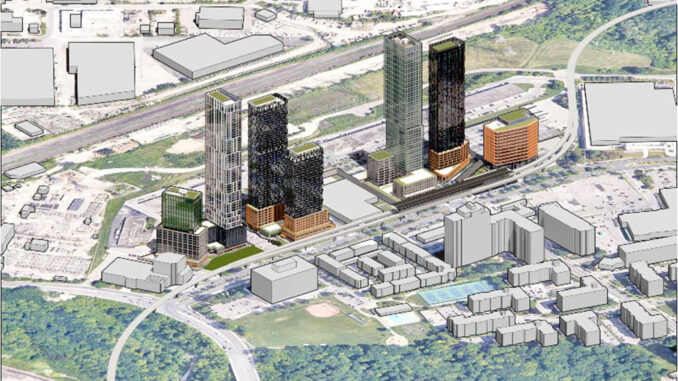
In case you missed it, the Ontario government recently announced a new development in Thorncliffe Park with six residential towers ranging from 24 to 56 storeys, and one office tower (13 storeys), for a total of over 2,660 residential units and 980 jobs, located on the north side of Overlea Boulevard, south and west of the future Ontario Line Maintenance and Service Facility (MSF), and adjacent to the future Thorncliffe Park Station on the Ontario Line.
Transit-oriented communities (TOC) place more housing and jobs near or at transit stations along the route of the province’s subway projects, including the Ontario Line. The TOC is intended to provide “real opportunities to build vibrant, higher density, mixed-use communities that are connected to transit stations.” While acknowledging that planning for increased density around transit stations can be a sensible strategy, there are a number of issues raised by this announcement.
Why is the Province usurping the City’s role?
The Thorncliffe Park TOC amounts to the Province usurping the City’s legitimate role in land use planning for communities impacted by major transit development. The Province could have set a target for people and jobs around the Ontario Line stations and left the job of planning the land use to the City – where it belongs.
A planning and development project of this scale should have triggered a comprehensive land use planning exercise by the City, with full public involvement, similar to Eglinton Connects, undertaken in anticipation of the Eglinton Crosstown LRT. The Yonge Eglinton Secondary Plan, approved by the Province in 2019, one year after submission, to permit densities four times higher than the City had planned. In Thorncliffe Park the Province has developed detailed plans for an area in Thorncliffe Park without the benefits of first doing a comprehensive community planning study.
Is the location appropriate for residential development?
This project amounts to a massive conversion of land use within the Leaside Business Park. The lands to be developed are designated Employment Lands (non-core) and house various commercial and office enterprises. The Province recently acquired lands for the maintenance and service facility north and east of the TOD site – but that is an industrial use and maintains “Employment Lands.”
It would have made more sense to plan for a redevelopment of the East York Town Centre, across Overlea Boulevard from the TP station. Replacing large shopping centre parking lots with towers has become a common development trend recently. Witness Fairview Mall, and Sherway Gardens. Why were these lands chosen over EY Town Centre?
Is the project misnamed – TOC or TOD?
The project is part of Infrastructure Ontario’s (IO) Transit Oriented Community (TOC) program umbrella when it is really Transit-Oriented Development (TOD). The distinction is important. TOC aims for a complete community with parkland, community space, daycares, schools, affordable housing, emergency services and other amenities.
TOD aims at maximizing returns to the Province and their development partners at the expense of the future community, which is deprived of the necessary services and supports.
The proposal consists basically of residential development, and some retail and office uses. Where are the schools, medical facilities, etc. given they are at capacity in TP and Leaside? How is the project linked to the rest of the Leaside Business Park, which would logically be expected to provide employment for new residents?
What about the Community Benefits Agreement?
Unlike during the construction of the Eglinton Crosstown LRT, Metrolinx has not signed a formal Community Benefits Agreement as part of the Ontario Line development. A community benefits agreement typically includes targeted commitments to local and equity hiring for development projects and are legally enforceable. Don Valley West MPP Stephanie Bowman has called on the provincial government to keep its promises to local communities like Thorncliffe Park and sign a Community Benefits Agreement.
Where is the affordable housing?
Again, there are no affordability requirements. The Province required the City to report on Inclusive Zoning around Major Transit Station Areas (MTSAs) like Leaside (Bayview) station and designated it as a Protected Station Area (PMTSA), which required Inclusive Zoning – a minimum percentage of affordable units – but has never followed through and approved the extent of affordability in the MTSA/PMTSAs.
Is the public involved?
The application was submitted to the City in October 2023 and became public on January 29, 2024. Presumably it had been in the planning for several months (or years?). Infrastructure Ontario has arranged a Local Advisory Committee and has been holding some public information sessions (in person and virtual) to explain the project. However, the proposal has been developed in considerable detail, and as such the consultations appear to be largely for information only.
How is the City involved?
Unlike the Ontario Line projects to the south of Thorncliffe Park, IO and Metrolinx projects in Thorncliffe Park currently have no oversight from City Council. Toronto and East York Council established a subcommittee on the Ontario Line in February 2023, which reports quarterly on the Ontario Line and related matters with respect to its territory, but that does not include the three stations in North York district, i.e. Thorncliffe Park, Flemingdon Park, and the Ontario Science Centre, or the Ontario Line Maintenance and Service Facility (MSF).
The Leaside Residents Association (LRA), the Leaside Business Park Association (LBPA) and The Neighbourhood Office (TNO) signed a joint letter to Councillors Jaye Robinson and Jon Burnside in February asking for something similar to be established to provide City monitoring and oversight in Wards 15 and 16.


